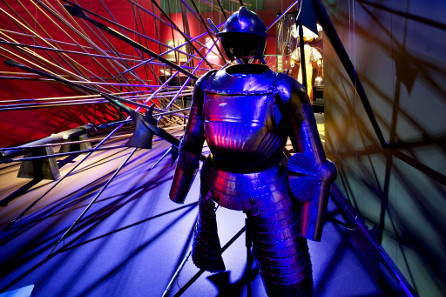April 16, 2015 – The exhibition “1515 Marignano”, on at the National Museum Zurich until 28 June 2015, examines the reasons behind the struggle to control Milan and the consequences of the war. The powers within Europe were battling for supremacy over Lombardy. Notably, the Swiss Confederation played a major role. The exhibition focuses on Milan around the year 1500 as the apple of discord, the battle as a major military event and the consequences of the Peace of 1516 for the Swiss. The Battle of Marignano is thus an encounter with an episode in European history between war and diplomacy.
Selected exhibits
“1515 Marignano” features around 250 important exhibits of outstanding quality from Switzerland and abroad. Dukes and military commanders depicted in exclusive Renaissance portraits assert their presence in the exhibition.
Papal gift. © Swiss National Museum.
Precious spoils from the Burgundian war testify to the rise of the Swiss as a military power. The splendour of the papal gifts of 1512 illuminates Switzerland at the pinnacle of its military prestige.
Venetian depiction of battle.
Drawings by artists who fought in the Milan wars provide first-hand accounts of the lives and deaths of Swiss mercenaries. A heavy canon from the French royal arsenal represents the technical military superiority of France in the conflict.
“Profitable peace”. Photo: Primula Bosshard.
And the impressive Treaty of Perpetual Peace of 1516 with its 19 different seals symbolises the political weight of the peace concluded between Switzerland and France. Beside Ferdinand Hodler’s renowned artwork “The Retreat from Marignano” in the Ruhmeshalle (Hall of Glory), a draft of the fresco is also displayed in the exhibition, on loan from the Kunsthaus Zürich.
The battle in context
Bugle calls, drum rolls, the thunder of French cannons: through image and sound, the exhibition depicts the force and violence of the “Battle of Giants”. A sound backdrop and animated battle scenes allow visitors to experience how the twenty-hour battle may have played out.
Leisure time in the military camp. © Museum zu Allerheiligen, Schaffhausen / Swiss National Museum.
Reportages depict major steps in the unfolding events: the election of the first Swiss commander-in-chief in 1512, appointment of the first bailiffs (“landvogt”) in Lugano and Locarno in 1513, the French king’s victory celebration in 1515 in Milan and the path-breaking military alliance of 1521.
“Marignano” today
The defeat of the Swiss at Marignano was lamented by some, but others took it as an occasion to return to the “old” values of a more modest Swiss Confederation. Some see in Marignano the origin of the principle of Swiss neutrality which became established in the 19th and 20th centuries, while their antipodes challenge the “myth of Marignano”.
Citizen’s armour. © Swiss National Museum.
This year marks the 500th anniversary of the Battle of Marignano, and the Swiss National Museum is taking the opportunity to offer the public this far-reaching special exhibition. The exhibition will be accompanied by a three-part series of debates on the topic of “Marignano – between history, narrative, politics and culture”.
More information on the exhibition you may find on the website of the National Museum Zurich.
We reported in CoinsWeekly about the „Numismatic Sensitivities“ the battle of Marignano evoked nearly 500 years later.
And here you may read texts written by 18 authors in different languages on the battle of Marignano.









